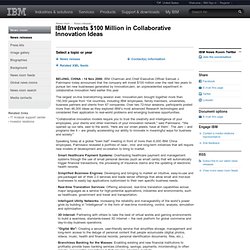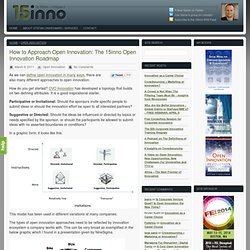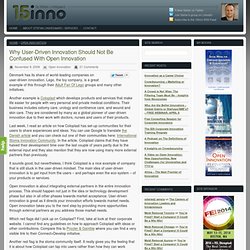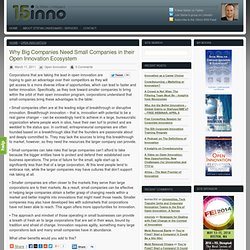

NHS Innovation Challenge Prizes. Of Open Source and Open Innovation. Last week I wrote about a talk I gave with the title “Innovation inducement prizes as a possible mechanism to unlock the benefits of open innovation models”.

I explored the idea of inducement prizes then, and now I'd like to look at open innovation. That concept rose to prominence with Henry Chesbrough's book, “Open Innovation - The New Imperative for Creating and Profiting from Technology”, published in 2003. It's a decent enough exploration of the idea from a business viewpoint, but what shocked me when I read it was that Linux is mentioned just once, on page 106, in the context of IBM, which was “able to create value for its customers through its embrace of open standards in a variety of areas, including the Linux operating system, the Java programming language, and the aforementioned HTML and http protocols.” That began, obviously, with Richard Stallman's announcement of the GNU project in September 1983: This emphasises two things.
Now move forward a couple of years to 1991. Soren Duus - IBM Innovation Jam.pdf (application/pdf Object) The Wisdom of Crowds. The Wisdom of Crowds: Why the Many Are Smarter Than the Few and How Collective Wisdom Shapes Business, Economies, Societies and Nations, published in 2004, is a book written by James Surowiecki about the aggregation of information in groups, resulting in decisions that, he argues, are often better than could have been made by any single member of the group.

The book presents numerous case studies and anecdotes to illustrate its argument, and touches on several fields, primarily economics and psychology. The opening anecdote relates Francis Galton's surprise that the crowd at a county fair accurately guessed the weight of an ox when their individual guesses were averaged (the average was closer to the ox's true butchered weight than the estimates of most crowd members, and also closer than any of the separate estimates made by cattle experts).[1] Types of crowd wisdom[edit] Surowiecki breaks down the advantages he sees in disorganized decisions into three main types, which he classifies as. IBM Jam Events. 2006-11-14 IBM Invests $100 Million in Collaborative Innovation Ideas. BEIJING, CHINA - 14 Nov 2006: IBM Chairman and Chief Executive Officer Samuel J.

Palmisano today announced that the company will invest $100 million over the next two years to pursue ten new businesses generated by InnovationJam, an unprecedented experiment in collaborative innovation held earlier this year. The largest on-line brainstorming session ever, InnovationJam brought together more than 150,000 people from 104 countries, including IBM employees, family members, universities, business partners and clients from 67 companies. Over two 72-hour sessions, participants posted more than 46,000 ideas as they explored IBM’s most advanced Research technologies and considered their application to real-world problems and emerging business opportunities. Covjam_SEO_PDF.pdf (application/pdf Object) IBM’s Innovation Jam 2008 shows how far crowdsourcing has come. IBM may be throwing a life raft to the stock market today, reporting unexpectedly high quarterly earnings.

Still, startups and venture capitalists may care more about the ideas floating at Big Blue’s annual research crowdsourcing event, dubbed IBM Innovation Jam 2008. IBM has been sponsoring the Innovation Jam for a few years now. The company’s researchers, employees and outside experts are invited to join in a virtual brainstorm session. They post their ideas for innovations and then others join in, commenting on the posts and voting for their favorites. The event taps into the idea behind James Surowiecki’s 2004 bestselling book, “The Wisdom of Crowds,” and the more recent “Crowdsourcing” book by Wired contritubing writer Jeff Howe.
IdeaStorm. Campbell's Ideas for Innovation. Healthcare and beauty product development from Boots Centre for Innovation. How to Approach Open Innovation: The 15inno Open Innovation Roadmap. As we can define open innovation in many ways, there are also many different approaches to open innovation.

How do you get started? OVO Innovation has developed a topology that builds on two defining attributes. It is a good inspirational starter. Participative or Invitational: Should the sponsors invite specific people to submit ideas or should the innovation effort be open to all interested partners? Suggestive or Directed: Should the ideas be influenced or directed by topics or needs specified by the sponsor, or should the participants be allowed to submit ideas with no asserted boundaries or conditions? In a graphic form, it looks like this. This model has been used in different variations at many companies. The types of open innovation approaches need to be reflected by innovation ecosystem a company works with. Another thing to consider is point-of-entry sites versus behind-the-scenes work.
Resources: Defining Open Innovation: The 15inno Open Innovation Roadmap. Open Innovation Examples and Resources. Why User-Driven Innovation Should Not Be Confused With Open Innovation. Denmark has its share of world-leading companies on user-driven innovation.

Lego, the toy company, is a great example of this through their Adult Fan Of Lego groups and many other initiatives. Another example is Coloplast which develops products and services that make life easier for people with very personal and private medical conditions. Open innovation versus user-driven innovation: Lego and Toyota cases. Why Big Companies Need Small Companies in their Open Innovation Ecosystem.
Corporations that are taking the lead in open innovation are hoping to gain an advantage over their competitors as they will get access to a more diverse inflow of opportunities, which can lead to faster and better innovation.

Specifically, as they look toward smaller companies to bring within the orbit of their open innovation program, corporations understand that small companies bring these advantages to the table: • Small companies often are at the leading edge of breakthrough or disruptive innovation. Breakthrough innovation – that is, innovation with potential to be a real game changer – can be exceedingly hard to achieve in a large, bureaucratic organization where people work in silos, have their own turf to protect and are wedded to the status quo. In contrast, entrepreneurial companies are often founded based on a breakthrough idea that the founders are passionate about and deeply committed to.
What other benefits would you add to this? InShare70. Open Innovation.